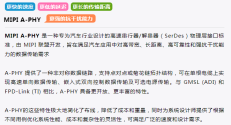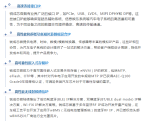Ruichengxinwei launches MIPI A-PHY IP: building an efficient data transmission network for automotive electronics
With the rapid advancement of automotive electronics technology, the demand for high-performance, highly reliable data transmission is increasing. From in-vehicle infotainment systems to the coordinated operation of various sensors and advanced driver assistance systems, efficient data connectivity is the key to enabling these complex functions. Ruichengxinwei is committed to providing cutting-edge solutions to the industry. Its recently launched MIPI A-PHY IP will support more diverse and agile "neural networks" for smart car applications.
In today's advanced driver assistance systems, numerous sensors, such as cameras, radars, and lidars, need to quickly and accurately transmit massive amounts of data collected to the intelligent driving computing unit for processing. MIPI A-PHY, with its high bandwidth and low latency, ensures real-time transmission of sensor data, providing a solid foundation for safe driving. For example, in intelligent driving scenarios, image data captured by high-definition cameras can be transmitted at high speed via A-PHY to the onboard computing platform, enabling precise perception and decision-making of the road environment.

As consumers' demands for in-car entertainment continue to rise, IVI systems must support higher-resolution displays and richer multimedia content. MIPI A-PHY can provide stable, high-speed connectivity for high-resolution infotainment displays, enabling smooth video playback and interactive experiences, enhancing the entertainment experience for drivers and passengers.
Ruichengxinwei has successfully developed MIPI A-PHY IP and, combined with its partners' PCS layer and controller IP, has helped several customers' chip products enter the tape-out verification stage. Through close collaboration with partners and customers, Ruichengxinwei will continue to optimize and improve the layout of MIPI A-PHY IP to better meet the growing needs of the automotive electronics market.
High bandwidth and low latency: Ruichengxinwei's MIPI A-PHY IP meets the A-PHY V1.1 standard and can support downlink data rates of up to 5Gbps (4Gbps for Downlink Gear G2) and uplink data rates of 50M, ensuring the rapid transmission of large amounts of data. At the same time, its extremely low latency characteristics can meet the extremely real-time requirements of application scenarios such as ADAS and autonomous driving, enabling vehicles to respond quickly to various road conditions and driving situations.


Long-distance transmission capability: The A-PHY standard supports transmission distances up to 15 meters, a feature particularly important in complex automotive wiring environments. Whether the sensor or surround-view camera is mounted on the front, rear, or side of the vehicle, A-PHY ensures a stable data connection without concerns about signal attenuation or transmission stability.
Excellent reliability and anti-interference capabilities: Cars are exposed to a variety of complex electromagnetic environments during operation. Ruichengxinwei's MIPI A-PHY IP has extremely high anti-interference capabilities, maintaining accurate and stable data transmission under strong electromagnetic interference. Its extremely low packet error rate provides reliable communication for safe vehicle operation. The IP also has high ESD resistance, passing the 8kV HBM test.
Support for Multiple Cable Types: Ruichengxinwei's MIPI A-PHY IP is compatible with a variety of cable types, such as shielded twisted pair (STP) and coaxial cable. This feature allows system designers to flexibly select the appropriate cable solution based on different application scenarios and cost budgets, effectively optimizing system costs while ensuring signal performance.
Based on a rich and powerful IP library, Ruichengxinwei has built a complete IP platform to provide partners with complete automotive IP platform solutions for different applications.


